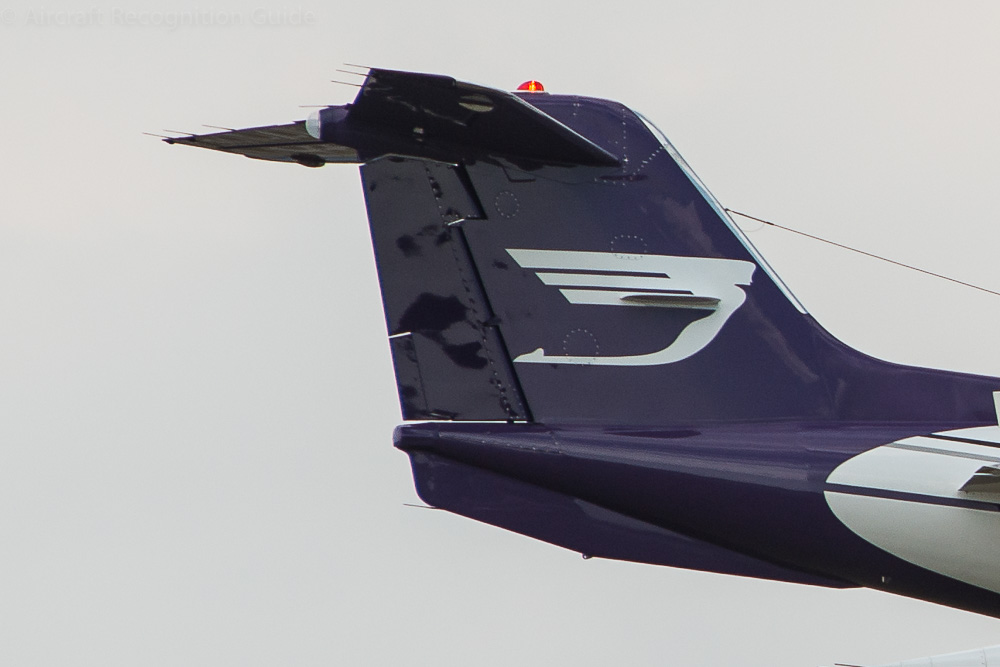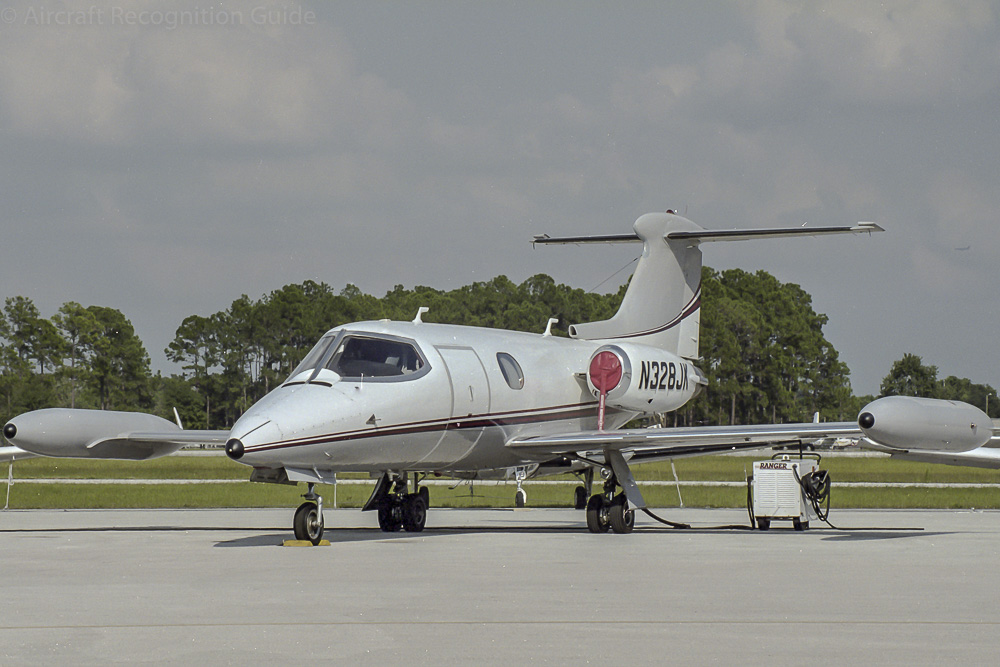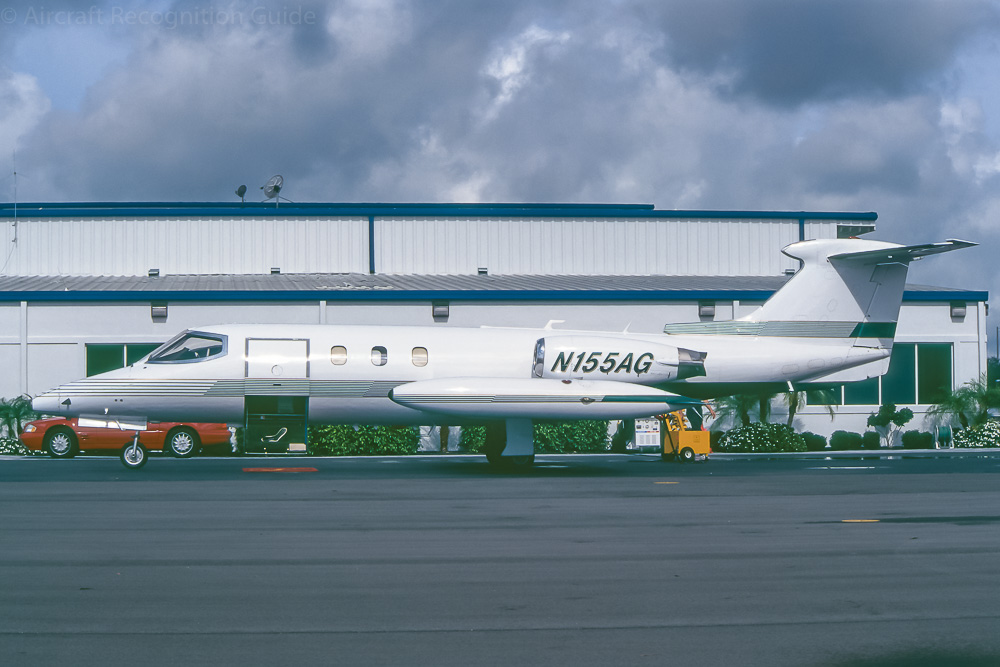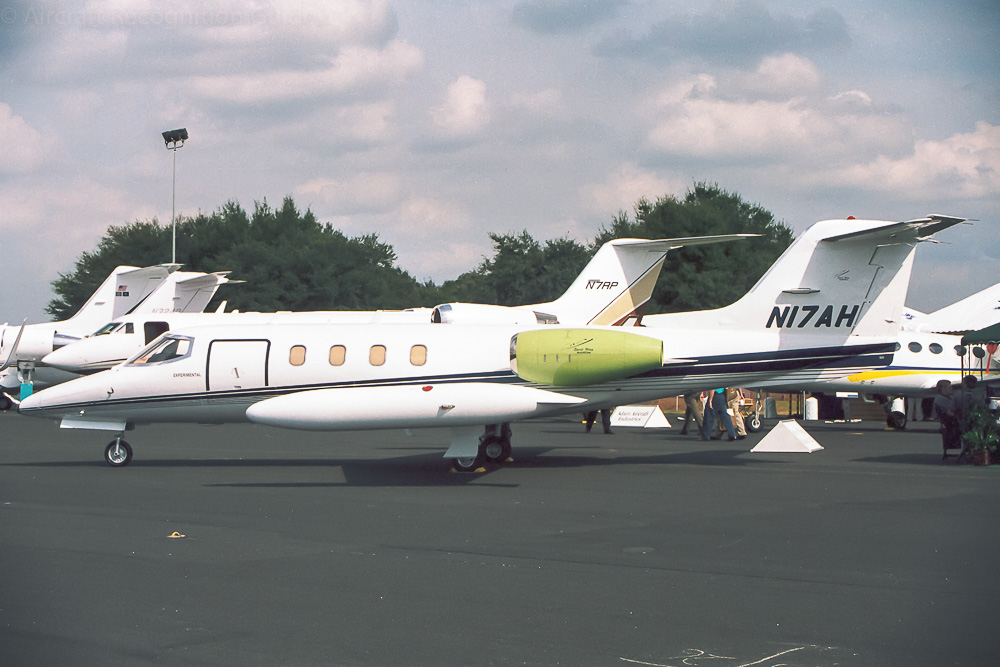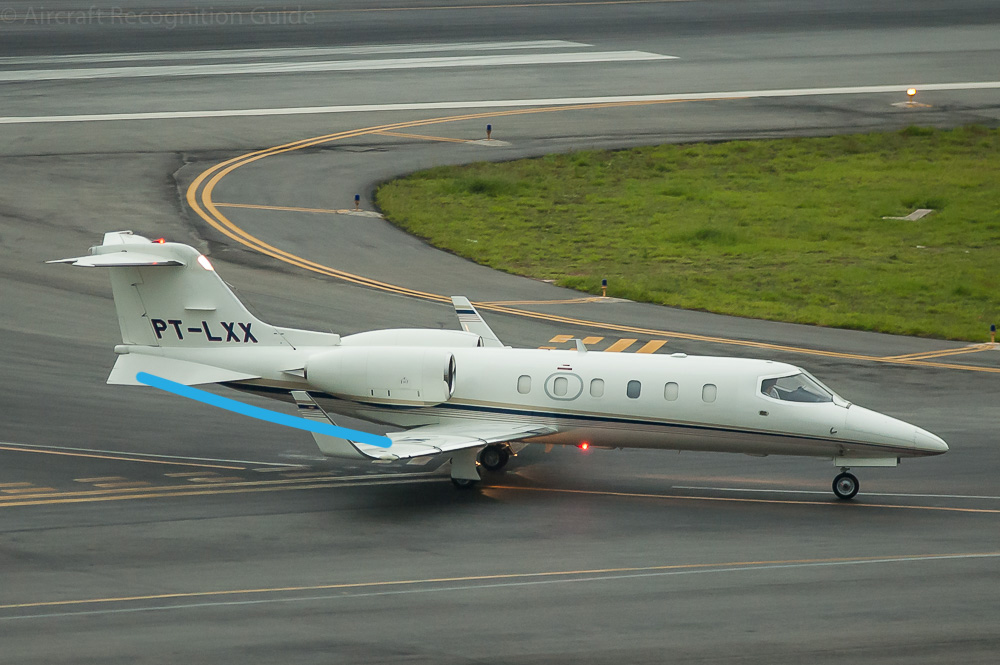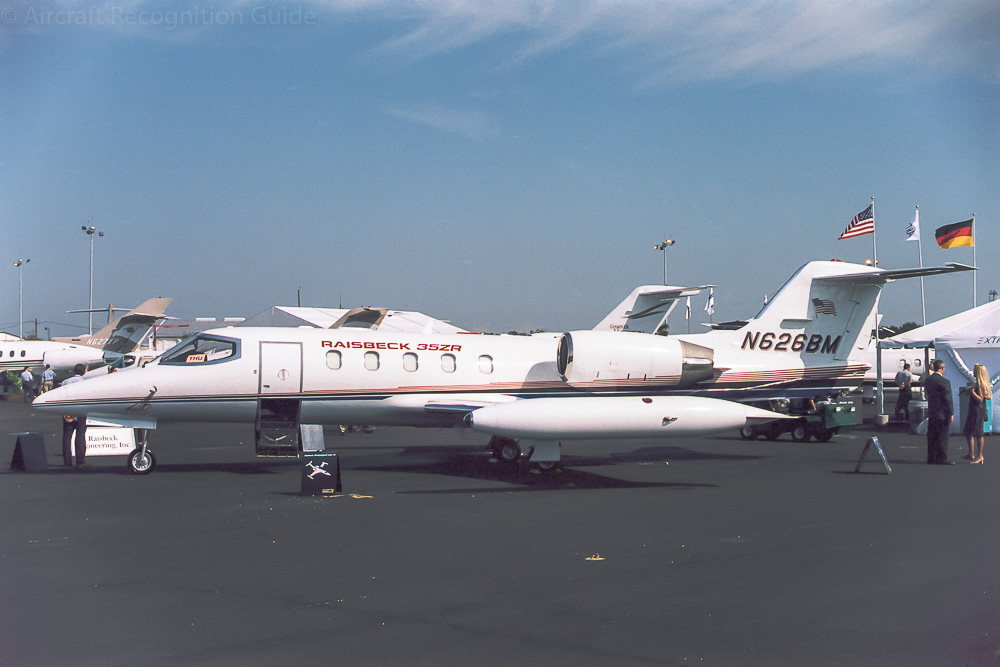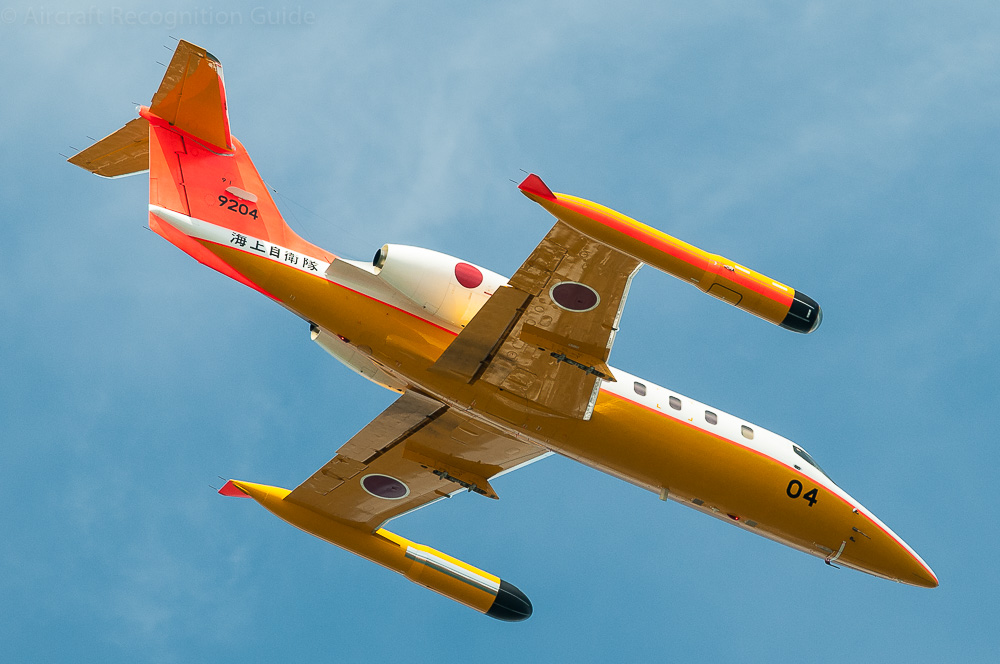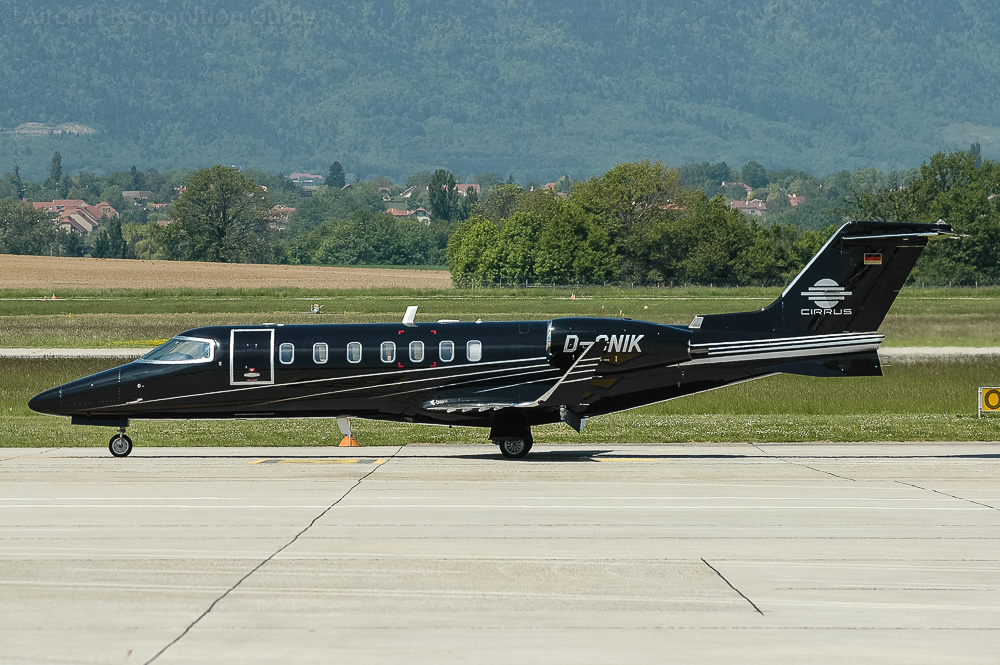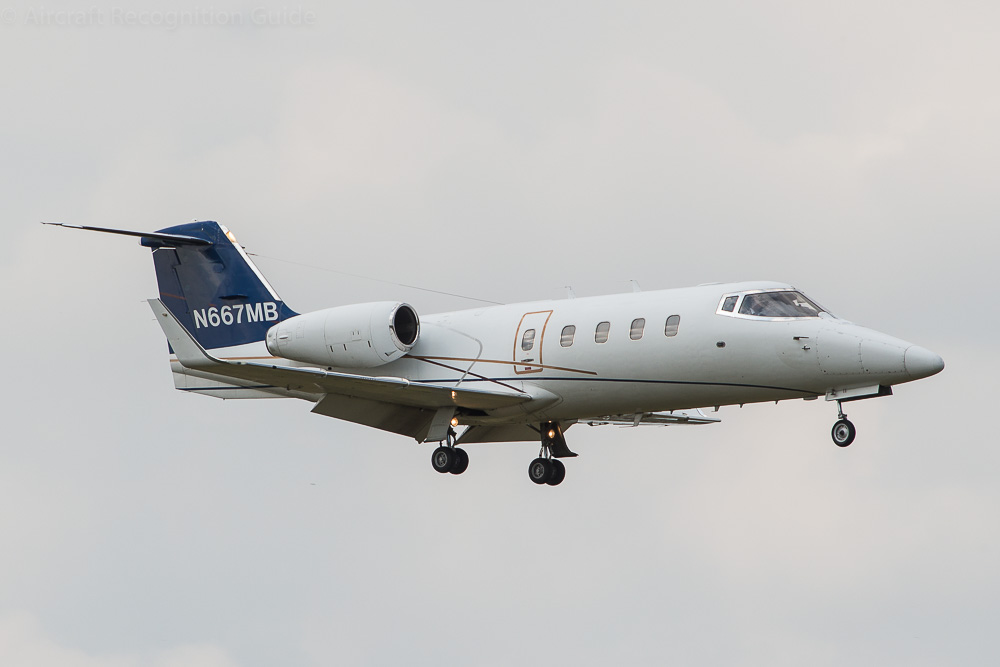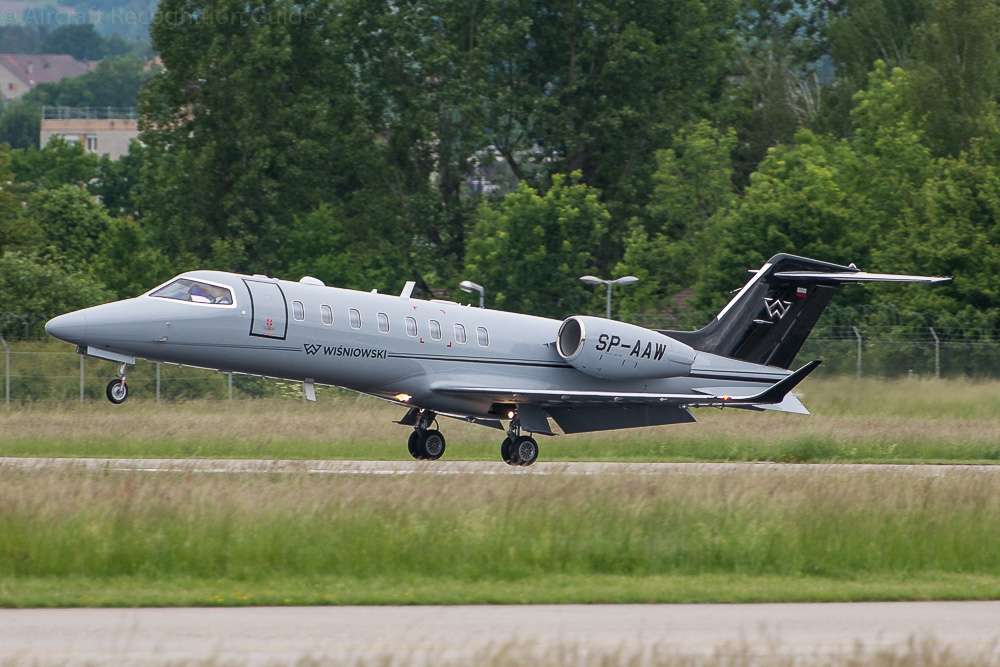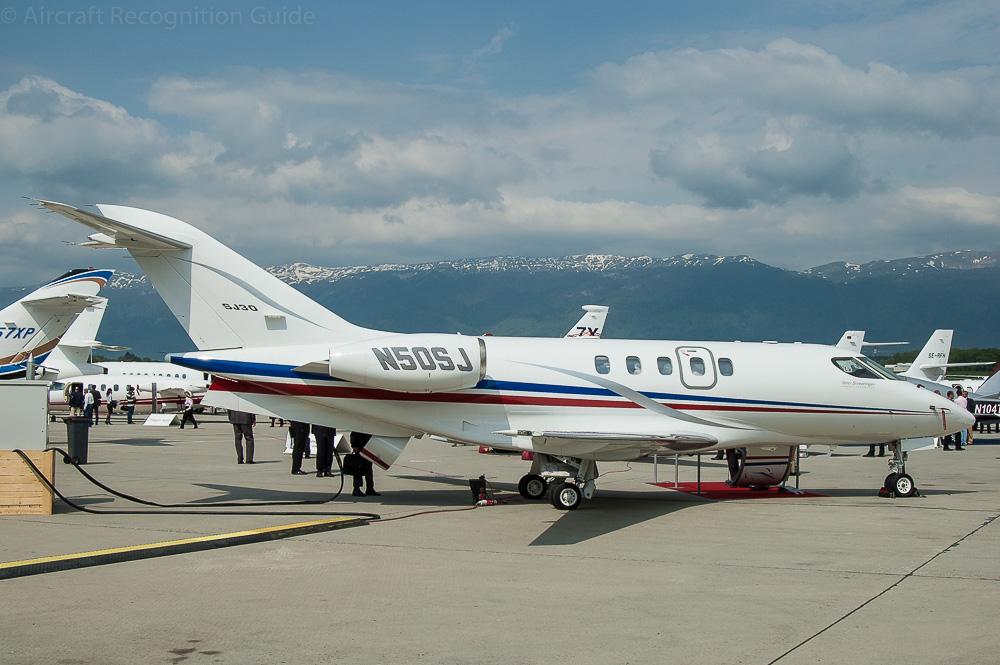
Learjet family
The Learjet is close to the synonym for a (small) private jet. That is not only because William Lear was one of the first to develop such an aircraft, but also due to its outstanding performance: even though the first Learjet models had nearly straight wings, they had a fighter-like performance. At first the Learjets were marketed and built by Lear Jet Corp. After a brief period being named Lear Jet Industries Inc. the company merged with Gates Aviation Corp. to create Gates Learjet Corp. Later in the 1980s it became Learjet Corp. again. This stayed so until Bombardier acquired the Learjet programme in 1990.
The Learjets are first characterised by their cockpit windows. Until the Learjet 55 all had two-piece curved cockpit windows. While the windows have changed a bit on later models, they are still very recognisable. Another feature of especially the early Learjets is the relatively small tail. The appearance is thus like of the Lockheed Starfighter.
Different versions
To differentiate between the different subtypes there is a lot to look at
- the length of the fuselage
- the shape of the cabin windows
- the number of the cabin windows
- the shape of the cockpit windows and window frames
- the shape of the engine nacelles
- the number of wheels on the main landing gear
- the shape of the wings
- the presence of tip tanks
- the presence of winglets
- the presence and shape of ventral fins
- the wing-fuselage attachment
Learjet 23
The first Learjets, including model 23, have in common the large oval cabin windows (one on the left, two on the right) and a so-called bullet fairing in front of the horizontal tail plane. Specific for the Learjet 23 are the cockpit window frames which are flat, including the one between the two windows. The window defrosters are slightly separated from the central frame. Also, the emergency exit in the second large window on the right has no handle on the outside like on the 24.
The early model Learjets look just like Lockheed Starfighters with their tip tanks and T-tail, but then with a bigger fuselage. Its performance is likewise.
Another key feature of early model Learjets are the large oval cabin windows. The Learjet 23 has no visible external handle at the edge of the emergency exit in the second window.
The Learjet 23 and first versions of the Learjet 24 have a small bullet fairing on top of the vertical stabiliser and an air intake at the root of the dorsal fin.
Original Learjet 23s have flat frames around the cockpit windows, although some are known to have been modified with those of the Learjet 24.
Learjet 24, 24A, 24B, 24B-A
We have put these model Learjets under one heading because there are no known external differences. They still have the large oval cabin windows (one on the left, two on the right) and a so-called bullet fairing in front of the horizontal tail plane. Unlike the Learjet 23s the 24s have a raised central cockpit window frame, increasing its strength. Moreover, the 24 has a sort of handle on the outside in the emergency exit in the second large window on the right, not present at the 23.
The Learjet 24 sub versions mentioned here differ in the engines (though all versions of the General Electric CJ610), maximum weights and internal systems.
Zooming in you can better see the raised central cockpit window frame, and the shape of the window defrosters.
Learjet 24C, 24D, 24E, 24F
These Learjet 24s still have the short fuselage, but the large cabin windows have been replaced by more smaller (three on each side). Furthermore, the bullet fairing disappeared.
From the Learjet 24C on the bullet fairing is gone as are the large cabin window. Three smaller rectangular windows remain on this Learjet 24D.
Learjet 24XR
To increase the performance of the Learjet 24, Dee Howard developed a series of aerodynamic modifications to existing Learjet 24s. The most visible is the thicker wing with wider chord, near the wing root. Hence the leading edge starts below the second cabin window instead of the third window.
The Learjet 24XR has a thicker wing with a larger wing chord at the root than the standard 24s. Look at the wing attachment point compared to the Learjet 24D above. (photo WikiMedia/Aeroprints)
Learjet 25
The Learjet 25 is the stretched version of the Learjet 24 and has, in most cases, four small windows on the left side and five on the right. But there may also be less windows! In addition, the first subversion of the 25 also has the bullet fairing of the early model Learjet 24s on the tail.
Originally the stretched Learjet 25 kept the bullet fairing on top of the vertical stabiliser, like on the early model 23s/24s. Note that this one has just three cabin windows on the left side!
Learjet 25B, 25C, 25D, 25F
These are also noisy Learjet types, which differ from the first model Learjet 25 by no longer having a bullet fairing. Between the subversions no differences are visible on the outside.
The Learjet 25B and later versions of model 25 have no bullet fairing on the tail. Note the location of the wing root leading compared to the Learjet 25XR below.
Learjet 25G & 25XR
The performance enhancing measures of the Learjet 24XR are also available for Learjet 25s. The modifications are slightly different, but also include a re-designed inboard wing like the Learjet 35ZR (see below).
Learjet built some of these Learjet 25s as new, under the designation Learjet 25G. This version is not included on Learjet 25 type certificate, but there is only a supplemental type certificate (STC).
Learjet 25Gs and 25XRs (shown here) have a recontoured wing root, which starts somewhat more forward than on standard Learjet 25s.
Learjet 25TF
In the early eighties Robertson Aircraft developed a series of improvements for the Learjet 25s, which involved the installation of winglets on the tip tanks and replacement of the original CJ610 engines by JT15Ds. To our knowledge, only one aircraft was fitted with winglets (c/n 25-036), but has none of the other planned modifications. Then it became quiet around the Learjet 25TF project and the aircraft was converted back to Learjet 25..
Later Spirit Wing tried the same but then with Williams FJ44 engines. One Learjet 25D (c/n 25D-316) was converted.
Learjet 28 & 29
Learjet developed a new swept wing for the Learjet, which also has winglets. This was first applied to the Learjet 28, which is actually a Learjet 25D with the new Longhorn wing. So watch for winglets instead of tip tanks on a CJ610 powered Learjet. The Learjet 29 is the long-range version of the 28, with only internal differences.
The Learjet 28 has the fuselage, slim engines and tail of the model 25D with the Longhorn swept wings with winglets.
Learjet 31 & 31A
This is a hybrid of the Learjet 35, of which the fuselage, tail and engines were used, and the Learjet 55, that provided the wings. So it has a narrow fuselage, turbofan engines and winglets. Also standard are the two ventral fins - called “delta fins” - behind the engines. However, these are also available from Avcon as a retrofit on the Learjet 35. There are no external differences between the Learjet 31 and 31A.
Raisbeck Engineering produces an aft fuselage locker as a modification to existing Learjet 31 and 35/36s. In a bulge under the rear fuselage more bagage room is created.
Learjet 35, 36, 35A & 36A
The Learjet 35/36, with subversions, has the largest production run of all Learjet models. This model was created by lengthening the fuselage of the Learjet 25, extending the wingspan and replacing the CJ610s by TFE731 turbofans. As with Model 28 Learjet also offered a version with a longer range, the Learjet 36.
Subtle, so not really visible modifications to the wings resulted in the Learjet 35A and 36A respectively.
Notes on military versions:
- The Learjet 35A is designated C‑21A with the USAF.
- The Learjet 36A is called U-36A in Japan.
- C-35, R-35A and VU-35A are the designations in Brazil.
- A Learjet 35A is called Tp104 in Swedish military service.
Raisbeck Engineering offered really distinguishable wing modifications to improve performance, much like Dee Howard did with the old Learjet. The inboard wing is fitted with a 45° swept glove extending out to about a third of the wingspan (larger than the Learjet 24XR/25XR), creating a sort of double-delta. There is also a smaller triangular fillet between the wing trailing edge and the tip tank. This ZR package seems not available anymore.
The company however still has an aft fuselage locker in its portofolio. This creates a bulge under the rear fuselage.
Avcon Industries is manufacturer of aft fuselage delta fins (double ventral fins) to improve directional stability for the Learjet 35/36.
A full view of the standard Learjet 35A. Note the significantly larger diameter engines compared to the Learjet 25, and the single ventral fin.
The US Air Force operates the militarised Learjet 35A designated as C-21A.
For improved performance Raisbeck Engineering modified a Learjet 35A with redesigned wing roots, marketed as Learjet 35ZR. Note that the wing root lines up with the third cabin window, compared to the fourth on a standard Lear 35.
Learjet 40 & 40XR
The Learjet 40 is the replacement for the Learjet 31A. It is a Learjet 45 with a meter shorter fuselage. Therefore, the Learjet 40 has six or seven cabin windows instead of eight. The Learjet 40XR is an upgraded version, offering better performance due to the upgrading of the engines to the TFE731-20BR configuration. This upgrade is also available to Learjet 40s.
Learjet 45 & 45XR
The first Learjet since the 23, that has been designed completely from scratch, is the Learjet 45. The differences with the other small Learjets are quite subtle, but if you look closely you can see some clear differences in the cockpit windows and the tail. Furthermore, the 45 has most cabin windows of all Learjets: eight. The Learjet 45XR is a subversion with better hot-and-high performance thanks to modified engines. A Learjet 45 can be easily converted to a 45XR.
A Learjet 45 with eight cabin windows and winglets perpendicular to the wings.
Learjet 55, 55B, 55ER & 55LR
The Longhorn wing with winglets got its second application on the Learjet 55, which also has a larger diameter fuselage. It can also be distinguished from the smaller Learjets by the “extra” cockpit side window. In comparison with the regular 55 the Learjet 55B, 55ER and 55LR have internal changes such other instruments, enlarged fuel tanks and higher take-off weights.
Learjet 55C
Like the Learjet 31, the Learjet 55C has large delta fins under the tail. Furthermore, there are no external differences with the other 55 subversions.
Remark: the Brazilian Air Force flies this type as VU-55C.
The Learjet 55C has two big ventral fins, called "delta fins". Compared to the Learjet 60 it has no external streamline bodies for the thrust reversers.
Learjet 60 & 60XR
Until now, the Learjet 60 is the largest of the Learjet series that has been mass-produced. It has a meter longer fuselage than the 55C. Hence, it has one cabin window more, five on the port side and six on the starboard side. Furthermore, the Pratt & Whitney PW305 engines have thrust reversers fairings that extent significantly behind the engine nacelles. That is the best recognition point. The 60XR only has a different avionics package.
Learjet 70
The successor of the Learjet 40XR is most easily recognisable by the different type of winglets: they have an angle of about 45° with the wing, less than the original winglets of the Longhorn wing.
Learjet 70
Learjet 75
Just like the main difference between the Learjet 40XR and Learjet 70 the so-called canted winglets have an angle of about 45° with the wing, less than on the Learjet 45XR.
To attract more customer Bombardier offers a lower cost Learjet 75, marketed as Learjet 75 Liberty. It has six seats and standard no APU.
Learjet 85
The banner of largest Learjet was to be taken over by the Learjet 85. Just one prototype had flown before the development programme was cancelled. The Learjet 85 has wings that go underneath the fuselage, therefore not protruding the cabin. To reduce drag it has a large wing-fuselage fairing.
The Learjet 85 prototype was the single example of the largest Learjet ever built. (photo: Florida Metal)
Confusion possible with
Embraer 505 Phenom 300
Many of the Learjet family could be potentially mixed up with the Phenom 300, especially the ones with winglets like the Learjet 28/29, 31 and 40/45. Other models are bigger (Learjet 55/60) or have tip tanks, making confusion less likely.
Pilatus PC-24
Another aircraft that looks like a Learjet - in particular the Learjet 45 and 55 - is the Pilatus PC-24. The differences compared to the Learjets are mainly the cockpit windows (four windows of about equal size), the cut off dorsal fin and lack of winglets.
Sino-Swearingen SJ30
Unusual for the SJ30 are the legs of the main landing gear, which look somewhat like those of a Jaguar fighter, the leading edge of the vertical stabiliser, curved al the way to the trailing edge. This is the best way to distinguish it from Learjets without tip tanks (although Learjets then have winglets, which the SJ30 hasn't).


